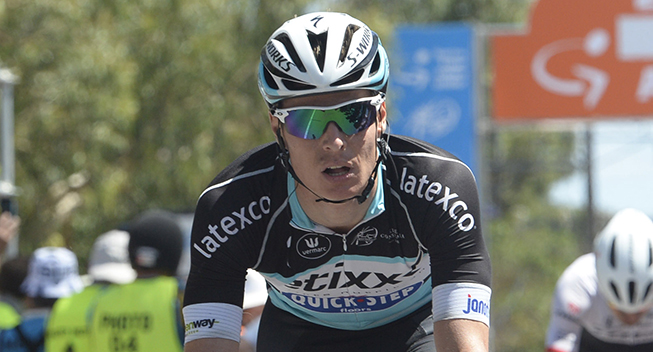There was no fairytale ending for Cadel Evans (BMC) in the final race of his career as he had to settle for 5th in a dramatic and entertaining inaugural edition of the Cadel Evans Great Ocean Road Race. Instead, it was Gianni Meersman (Etixx-QuickStep) who came away with the win after he had made it into the decisive 9-rider group before he beat Simon Clarke (Orica-GreenEDGE) and Nathan Haas (Cannondale-Garmin) in the final sprint.
Gianni Meersman desperately tried to win a stage in the Tour Down Under where his Etixx-QuickStep team often played with the muscles in the sprint stages. However, the terrain was either too hard or too easy for the versatile Belgian who excels in sprints on tough days.
Today he finally found the terrain and weather conditions he was looking for when he became the first rider to win the Cadel Evans Great Ocean Road Race which has been created in the legacy of Australia’s best rider ever who waved goodbye to his career at today’s event. With wind, rain and small climbs, the race had all the characteristics to turn into a true Australian classic and that made it a tough affair in which Meersman could excel.
Cannondale-Garmin had used the windy conditions on the big opening loop of the race to split the peloton to pieces, eliminating pre-race favourite Caleb Ewan (Orica-GreenEDGE). At one point, the front group was down to less than 20 riders but when they reached the three laps of the 20.2km finishing circuit, more riders had rejoined from behind.
The American team tried to send Jack Bauer into a first move at a point when things were very difficult to control but on the penultimate lap, BMC brought those riders back. Now Evans’ team went on the attack by launching Danilo Wyss into a move where he was joined by Pieter Serry (Etixx-QuickStep) and Ian Stannard (Sky) and later also Simon Clarke and Martin Elmiger (IAM).
On the final climb with 12km to go, Wyss and Clarke turned out to be the strongest and they managed to stay clear even though Cannondale-Garmin had almost brought them back at the bottom of the ascent. On the steep slopes, a reinvigorated Moreno Moser (Cannondale-Garmin) played with the muscles and together with an in-form Peter Kennaugh (Sky), he joined the two leaders.
Giampaolo Caruso (Katusha) bridged the gap on the descent before Evans got into contention for a win in his home race when he also made it across alongside Meersman, David de la Cruz (Etixx-QuickStep) and Nathan Haas. Luke Rowe (Sky) was the final rider to make it across before de la Cruz started to ride tempo on the front to set Meersman up for a sprint win.
Clarke was the first rider to try to get clear but it was Moser who finally made a difference on a small climb with 6km to go. While de la Cruz paid the price for his hard work and fell back, the Italian built a gap of around 10 seconds.
Kennaugh and Wyss led the chase for their sprinters Rowe and Evans and with 3km to go, it was over for Moser. Instead, Rowe briefly tried to make a move before Moser started to ride tempo for his fast teammate Haas.
However, it was Kennaugh who led the group for the final 2km and made sure that they held off a hard-chasing peloton that was getting very close in the end. Rowe tried to finish off Kennaugh’s strong work by launching a long sprint but he was quickly passed by Haas. However, Meersman timed everything perfectly to come around the Australian and he dragged Clarke along, with the Orica-GreenEDGE rider narrowly edging Haas out in the battle for second.
There was no fairytale end for Evans but with a fifth place, the Australian was a protagonist in the final race of his career.
Many of the riders from today’s race will be back in action on Wednesday for the final big event of the Australian summer. Orica-GreenEDGE will lead the charge as they try to defend Clarke’s overall win in the five-day Herald Sun Tour that brings a hard block of racing in Australia to a close.
A small classic
The inaugural edition of the Cadel Evans Great Ocean Road Race took place on a 173.9km course that was split into two parts. First the riders tackled a 113km circuit that included several stretches along the ocean and a few smaller climbs in the second half. In the final, the riders did three laps of a 20.2km circuit around the city of Geelong which included a small steep climb 12km from the finish.
The riders left Geelong under an overcast sky and with lots of wind, a real classic was in store. It didn’t take long for the rain to come out, meaning that the conditions got even tougher.
A fast start
As expected, the race got off to a very fast start with lots of attacks right from the beginning and it was three riders who made the first attack of the day. As they were brought back, the attacking continued but the riders covered more than 10km before something finally stuck.
Laurent Didier (Trek), Marco Frapporti (Androni), Darcy Woolley (African Wildlife Safaris) and Josh Taylor (Charter Mason) managed to establish a small gap but they had to fight hard to maintain it. Meanwhile, Jacob Kauffmann (Budget Forklifts) and Harry Carpenter (UniSA-Australia) tried to bridge the gap but those two riders never made the junction.
Talbot joins the break
The gap was still a small one and so Brodie Talbot (Budget Forklifts) was the next rider to try to join the leaders. While he dangled around 30 seconds behind, the peloton finally slowed down and allowed the gap to reach 1.31 at the 20km mark.
Talbot stayed 30 seconds behind the front group for some time while Taylor beat Wooley and Frapporti in the first intermediate sprint. At the 30km mark, however, he finally made the junction and at this point the peloton was 5 minutes behind.
Didier crashes out of the break
Several teams worked together in the main group to bring the gap down to 4.30 where they kept it for a long time. Meanwhile, the rain had again stopped and Frapporti beat Woolley and Taylor to win the final intermediate sprint.
At the bottom of the first climb, the gap was down to 4 minutes but as Talbot led Woolley and Taylor over the top, they had extended it to 4.37. Unfortunately, Didier crashed out of the break and left the race with a suspected broken wrist.
Cannondale split the race
At the 73km mark, the peloton had accelerated and the gap was now only 3.41. Meanwhile, the peloton had now hit the crosswind and this signaled the start of the real action.
Cannondale-Garmin were eager to wreak havoc on the peloton and they set a brutal tempo just as it again started to rain. The peloton split to pieces and at the 95km mark, a 13-rider first echelon had been formed.
Kennaugh makes a move
The riders in the group were Wyss, Kennaugh, Rowe, Clarke, Mark Renshaw (Etixx-QuickStep), Haas, Moser, Bauer, Alex Howes, Davide Villella (both Cannondale-Garmin), Matthew Brammeier, Tyler Farrar (both MTN-Qhubeka) and Jesse Sergent (Trek), meaning that Cannondale-Garmin had all their riders on the attack. They quickly caught the front quartet while a second group was at 20 seconds, with the main group 20 seconds further adrift.
More riders managed to rejoin the front group and as they slowed down a bit, Kennaugh tried to attack. The British champion had an 11-second gap when he started the first lap of the finishing circuit while a bit of regrouping had taken place a bit further back.
Bouet launches an attack
Kennaugh was brought back and this opened the door for Maxime Bouet (Etixx-QuickStep) to make a move. He got a 14-second gap before he was joined by Bauer and later Darren Lapthorne (Drapac) also made the junction.
Bouet led Bauer and Lapthorne over the top of the climb for the first time and at this point, they were 25 seconds ahead. An impressive Robert Power (UniSA-Australia) made use of the climb to bridge the gap and as the peloton was now more than a minute behind, Stef Clement (IAM), Patrick Shaw (Avanti) and Calvin Watson (Trek) also set off in pursuit.
The break is caught
At the start of the penultimate lap, the gaps were 37 seconds and 1.09 but BMC had now started to chase in the main group. As they went up the climb for the second time, the two front groups merged but the peloton was getting closer.
Bouet led Bauer and Power over the top but BMC had now brought the gap down to just 15 seconds. A few riders briefly managed to bridge across but when Bauer made a final desperate attempt to stay away, it signaled the end for the break.
Wyss kicks off the finale
BMC immediately sent Wyss off in an attack and he was quickly joined by Stannard and Serry. They built an advantage of 25 seconds while Clarke started to chase.
Elmiger was the next to take off in pursuit and those two riders both rejoined the front group in the early part of the final lap. However, Cannondale-Garmin had now started to chase and this set the scene for the exciting finale from which Meersman emerged as the strongest.
| Andrea FRAILE 32 years | today |
| Sergiy KLIMAKOV 35 years | today |
| Enzo ANTI 27 years | today |
| Gladys VERHULST 28 years | today |
| Tekau HAPAIRAI 47 years | today |
© CyclingQuotes.com









